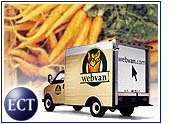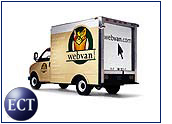
It seemed like the perfect solution for overworked, time-deprived 21st century consumers — online grocers to the rescue.
Even a year ago, the revolutionary prospect of selling perishables and food online held promise.
But a year online is like a day in conventional time, and what a difference a day has made in the e-grocery business. It seems that digital chicken sales, name-your-own-price veggies and grocery aisle surfing now typify the uphill struggle of e-tailers.
Can online grocery shopping find its legs?
The key to success, or at least survival, for online grocers may be smart partnering and consolidation. Weaker links may face extinction, but whatever market share is left could be divided among those with established allies.
All Lanes, No Waiting
Just last week, one of the old-timers in the business, Webvan, let loose with the news that its founder, Louis Borders is leaving for “personal reasons.”
Could it be that Mr. Borders found it “personally” the best time to depart because Webvan is short of economic breath? After all, fourth quarter results were dismal, with losses of US$109 million, or 23 cents per share — close to twice the figure of the previous year’s Q4 losses.
Look for Webvan to find a tougher big brother with whom to affiliate, perhaps something similar to last summer’s GroceryWorks.com deal with the almighty brick-and-mortar giant Safeway.
A sweet win/win deal that one was, offering Safeway a path to Internet sales without having to start from square one, while GroceryWorks got a hefty cash infusion and the Safeway name to bolster its credibility.
Single-Digit Constituency
Nevertheless, the jury is still out on whether online grocers have a viable place in electronic commerce. Jupiter Research reports that although the business will net $2 billion this year, online grocery sales make up less than 1 percent of grocery sales in the US.
With odds like that, who would even consider entering the online grocery business? Three words: bricks and clicks.
While most major supermarket chains are struggling financially, the two that are holding their own are Safeway and Kroger — the only two majors that have taken aggressive online chances.
Electric Avenues
For its part, Kroger hopes to find a good online grocery sales model, but does not see that as its only online prospect. While it patiently works on the retail end, it is moving full steam ahead using the Internet to strengthen its supply chain.
Last year, Kroger took an equity stake in GlobalNetXchange, the online retail industry exchange that boasts other big names like Sears. It’s clever strategy: cut purchasing costs, improve supply chain operations and all the while step cautiously into e-sales.
If and when online grocery shopping finds a mass audience, Kroger will be fully positioned to take maximum advantage of a new market segment.
Knock Knock
Still, even the toughest competitors in the online grocery business have one apparently insurmountable roadblock: nobody in America is home.
That’s not a huge problem for an online bookseller that might leave a delivery with a neighbor or follow alternative instructions. But how do you deliver bags or boxes of food when nobody’s there to answer the door?
It’s not that all perishables can’t find an online market. Consider the online floral business, a booming enterprise which also depends on successful delivery. The difference is, flowers and chocolates can be delivered to a recipient’s place of business.
Who’s There?
Some online grocers have tried to have consumers place the order online and then pick it up at a brick-and-mortar location. That defeats the purpose, since once the shopper is in the store, the sights, sounds and smells may make him wish he had simply shopped the old fashioned way. Think marketing strategy.
Additionally, even if this method works for brick-and-mortar establishments, it still does not bolster the possibilities of pure-play online grocers.
Some of those ventures have asked consumers to simply give them a key to their home and they’ll conveniently bring the delivery in and put it in the fridge.
Uh-huh. Right. That’ll happen.
Why Re-Invent The Wheel?
Peapods and Webvans notwithstanding, chances are the pure-play online grocer market share may remain in the single digits and therefore disappear.
That’s not to say there isn’t something of a market for ordering dog food, steaks and pastries online, but it’s likely to be gobbled up by brick-and-mortars who wish to diversify into online sales. They’ve got the inventory, the money and the warehouses already, and most of all, they’ve got names America trusts.
What do you think? Let’s talk about it.![]()
Note: The opinions expressed by our columnists are their own and do not necessarily reflect the views of the E-Commerce Times or its management.





















































Social Media
See all Social Media